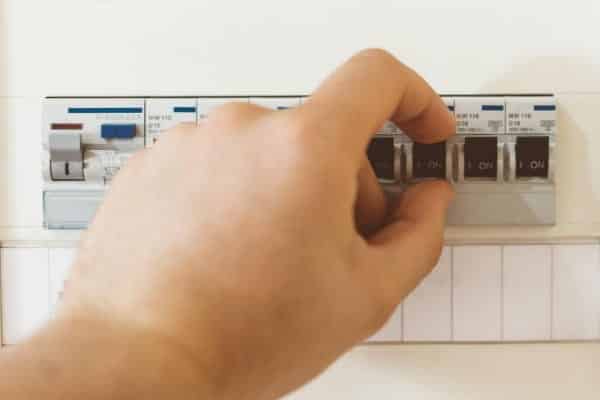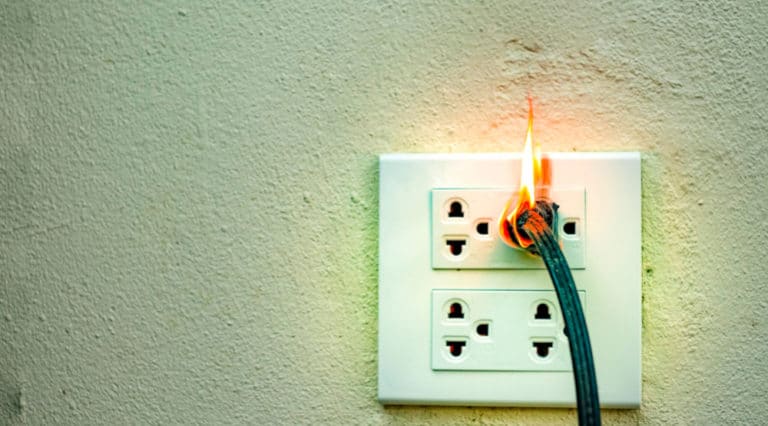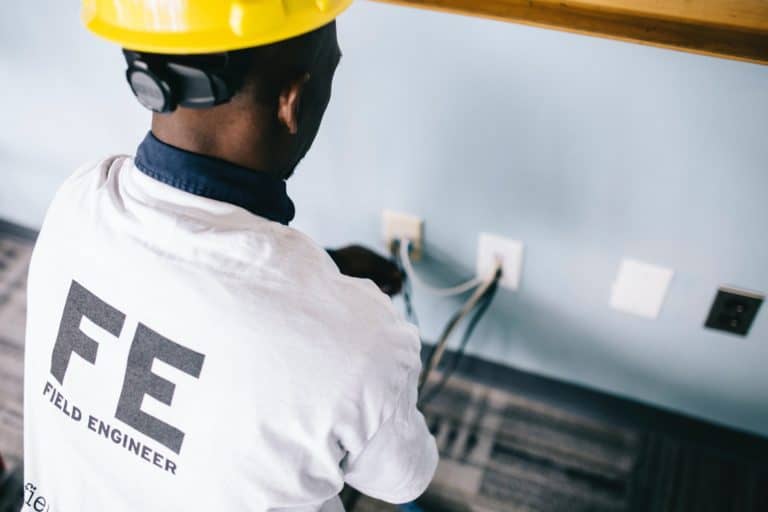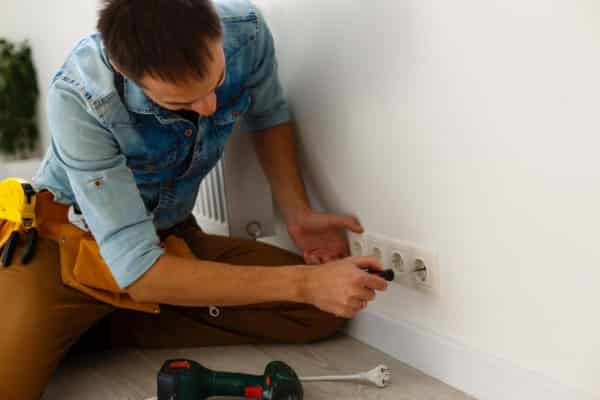Find My Local Expert When is the Best Time to...
Read More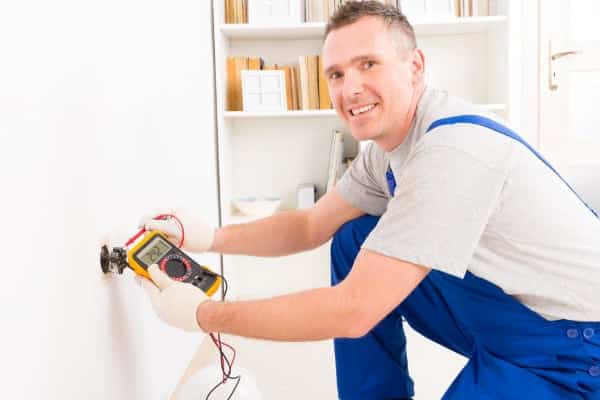
Securing a loose electrical outlet
Most of us are well aware of the dangers of electricity—especially with the amount of power that is fed into a residential or commercial property. We understand that electricity in these voltages is enough to start electrical fires, severely injure, and even fatally injure people. Surprisingly, despite this common knowledge, many of us have a tendency to be a little cavalier when it comes to something like a loose electrical outlet.
Loose electrical outlets can come in a few flavours. The outlet itself could be loose, meaning it is not securely fastened to the wall. It could also be loose in the sense that it does not properly grip the plug, allowing it to wobble or even fall out of the socket. It could also be loose in the sense that the wires that are connected to it are not connected very well.
All of these are significant causes for concern and should be addressed immediately, especially in homes where there are pets or children that may be down on the level of a loose electrical outlet. Generally speaking, the degree of risk is not important in homes like that, as any risk is seen as unacceptable.
Whatever the level of risk, it is important to remember that the dangers of something like a loose electrical outlet are not your dangers alone, but could well affect others in your home or premises, and even beyond in the case of electrical fires.
In this post, we are going to look at the dangers of a loose electrical outlet, as well as all you need to know about repairing it (and why you should probably leave it to an expert), so let’s get started.
The Dangers of a Loose Electrical Outlet
The first and most pressing danger of a loose electrical outlet is electrocution. If the socket is loose in gripping the plug, allowing the plug to hang out partially, it is possible your skin could come into contact with a live prong when you go to unplug it, which would not be good for your health.
Of course, if the rest of your electrical system is properly set up, this should not be the case, as your RCD should trip off the instant that the electricity finds an alternate path to travel. The path being you. This combined with the small chance that you would be able to get your fingers onto a prong without pulling the plug far enough from the socket that it would be disconnected makes electrocution quite unlikely.
Of course, if the socket is practically hanging off of the wall and the wires behind are fully exposed, the chances of getting your hands on a live electrical current go up significantly, but the bigger fear is electrical fires.
While your RCDs and breakers should prevent electrocution and severe electrical damage to appliances, it only needs a single spark to start a fire, and such a spark, if it were to happen, would happen at the instant that an exposed electrical wire shorted, meaning that the safety precautions in your fuse box would not be able to prevent it. If there is anything flammable near the outlet when such a spark happens, it could catch fire.
There are also more minor things to worry about, such as catching parts of your body on an outlet that is protruding from the wall, which can be both painful and cause plenty of damage if you manage to rip the socket from the wall.
What to do Before the Repair
Whether you are going to attempt to repair the loose socket yourself, or you plan to call in a professional, there are a few things to take care of before you get started. The first thing, of course, is to ensure there is no power going to that area. You should be able to isolate the sockets from the rest of your electrical systems. For some larger properties, you may have separate breakers for different regions of the building, allowing you to just cut the power to the sockets in that particular region, rather than all the sockets in the property. If you can’t isolate your affected socket, you will need to turn all the power off. It would be best to do this as a safety precaution, but it will certainly need to be done before any work can take place on the socket itself.
Next, clear away the area around the socket. Move any furniture or clutter in the vicinity, and make sure there is plenty of room to work in. The wiring behind an electrical outlet is small, fiddly, and in a confined space. You (or your emergency electrician) won’t want to be fighting for elbow room to work in with armchairs and tables crowding around.
If you are tackling the job yourself, your next step is to make sure you have all the tools you need ready to go before you start. We’ll get into what those tools might be below, but you should have everything to hand once you get started, especially if you are going to have to tackle the wiring behind the socket. It is incredibly frustrating to get a wire into position and then find out you need to get up and get a particular screwdriver that you forgot to bring.
What You Will Need
The exact tools you will need will depend on what exactly is loose. It should be noted that if the socket itself is loosely fixed to the wall, you should remove it entirely and check the connections. There should be some slack in the electrical wires, but if they have been wired in with not much slack, and the socket has been pulling away from the wall, it could have pulled the wires partially or completely out of their terminals. If you check this part of the socket and find any exposed wire sticking out of the terminals, it is worth loosening the terminal and making sure the wire is pushed as far in as it will go, even if it feels secure.
To that end, you will need a screwdriver to remove and then fix back in place the socket itself. The good news is that you should be able to see what kind of screwdriver you need by looking at the socket, though it is typically a small-to-medium sized flat head screwdriver for electrical outlets.
You are also going to need a screwdriver for the terminals themselves, which will be a much smaller flat head screwdriver. There are dedicated screwdrivers intended for this purpose, but if you don’t have one, any small flat-headed screwdriver should do the job.
Finally, and perhaps most importantly if you are tackling the job yourself, you should have a means of testing if the electricity is truly off for that socket. Obviously, a fully-functional multimeter would be ideal, but at the very least, you should have something like a mains tester screwdriver to hand.
Step-by-Step Guide
As we mentioned above, if the socket itself is loose in the wall, it is good practice to ensure that the electrical wires going to your socket are securely in place, even if there is little or no reason to believe they would have moved. If the socket is secure but anything you plug into it is loose, you are going to need to replace the socket, which means the first step, in either case, is the same; removing the outlet from the wall.
#1 Ensure Electrics are Off
After ensuring the electricity is off, remove the two screws that hold the outlet in place. This should free the outlet up, which should then come out of the wall casing very easily. If it offers any resistance, it is probably just down to a kink or bends in the wires catching on something; try gently moving the outlet up and down, side to side, and tilting it until it comes free.
#2 Replacing and Reconnecting the Outlet
If the outlet was loose, and you are just checking the wires, loosen the terminals and make sure the wires are pushed all the way in, then re-tighten. If the plug was loose, and you are replacing the outlet entirely, remove the wires, being careful to note where each wire went in case they have been wired up using non-standard wiring. Connect the wires to your new outlet, ensuring a firm connection in the terminals but without winding them in so tight that the wires break.
Finally, replace the socket, screw it firmly in place, and test.
Why You Should Hire a Professional
Despite the fact that this is a relatively minor electrical task, it is still better to hire a professional to take care of it. Electrical problems like this are, at best, an inconvenience as your breakers trip and cut power for the fifth time that week, but they can easily become an injury (minor or severe), or property damage, either to your home or appliances.
In short, the potential cost of doing the job wrong will nearly always outweigh the cost of hiring a professional to do the job right in the first place. And, with emergency electricians being available around the clock, there is less of a reason not to.
You May Also Like...
Top 7 Causes of Electrical Fires
Find My Local Expert Top 7 Causes of Electrical Fires...
Read MoreHow To Safely Identify Electrical Faults in Your Home
Find My Local Expert How To Safely Identify Electrical Faults...
Read MoreDo I Need an Electrician to Move an Electrical Outlet?
Find My Local Expert Do I Need an Electrician to...
Read More5 Tips on Upgrading Your Home Office Electrics
Find My Local Expert 5 Tips on Upgrading Your Home...
Read MoreSecure That Loose Electrical Outlet Today!
My Trusted Expert Guarantee
Experts Have Been Vetted & Approved
